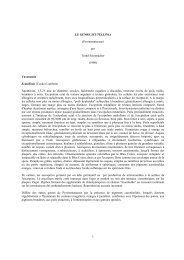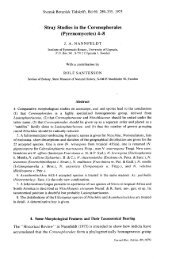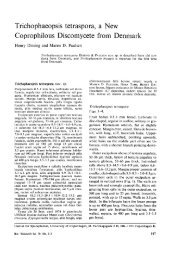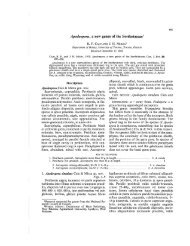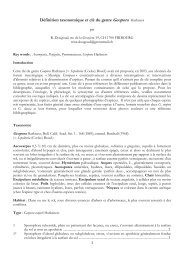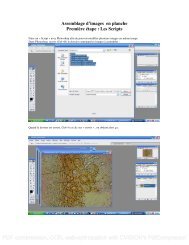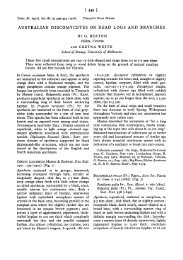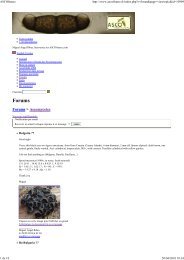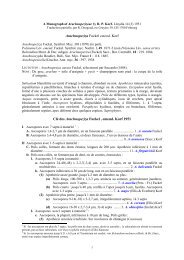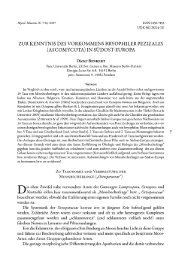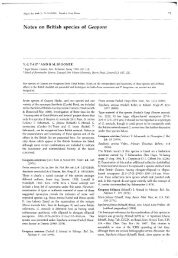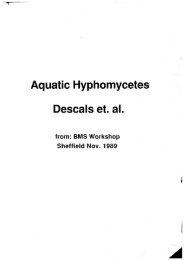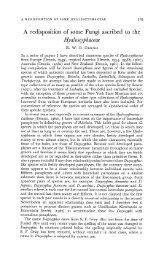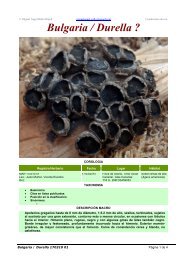LINDQUISTIA, A NEW HYPHOMYCETE GENUS1 - ASCOfrance
LINDQUISTIA, A NEW HYPHOMYCETE GENUS1 - ASCOfrance
LINDQUISTIA, A NEW HYPHOMYCETE GENUS1 - ASCOfrance
Create successful ePaper yourself
Turn your PDF publications into a flip-book with our unique Google optimized e-Paper software.
Boletín de la Sociedad Argentina de Botánica<br />
Volumen XVIII, Ni 1-2 (Noviembre 1977) págs. 145-151<br />
<strong>LINDQUISTIA</strong>, A <strong>NEW</strong> <strong>HYPHOMYCETE</strong> GENUS 1<br />
BY C. V. SUBRAMANIAN AND K. V. CHANDRASHEKARA 2<br />
RESUMEN<br />
Se describe un interesante hifomicete coprófilo, Lindquistia indica gen. &<br />
sp. nov., aislado de estiércol de mono de la India. Está asociado con ascostromas<br />
jóvenes de un hongo identificado como Podosordaria leporina (E. & E.) Dennis,<br />
We are delighted to contribute this paper to a volume intended to<br />
honour one so distinguished as Professor Dr. J. C. Lindquist whose<br />
contributions to mycology are so well known.<br />
In the course of our studies on the taxonomy and ecology of coprophilous<br />
fungi an interesting fungus was isolated from the dilution<br />
plates of monkey dung collected at the deer park, Madras. The fungus<br />
formed small white colonies with scanty aerial mycelium and soon produced<br />
white, erect synnemata-like structures. This, on subsequent transfer<br />
to fresh potato dextrose agar slants and plates, produced a stromatic<br />
ascomycete which could be identified as Podosordaria leporina (Ellis<br />
& Everh.) .Dennis. At first, while still on the dilution plates, the fungus<br />
with its typical synnemata and conidial structures was taken to be a<br />
Hyphomycete; but subsequent study of the fungus in pure culture revealed<br />
that the fungus is Podosordaria leporina with its conidial state<br />
and also that the synnema-like structures were but the young and developing<br />
ascostromata. Fully developed stromata with mature perithecia<br />
were produced after 3-4 weeks of inoculation on to fresh medium.<br />
Podosordaria leporina is a well known fungus and has been studied<br />
by several students (Seaver et al., 1927; Koehn, 1971; Krug & Cain,<br />
1974) and it has also been reported from India (Mukerji et al., 1969.<br />
as Poronia leporina Ellis & Everh.) The perfect state of this fungus is<br />
1<br />
Memoir N? 204 from the Centre for Advanced Study in Botany, University<br />
of Madras.<br />
2<br />
Centre for Advanced Study in Botany, University of Madras, Madras 600005,<br />
India.
well studied and described in the literature. However, little is known<br />
about its conidial state and is the main subject of this paper. A brief<br />
description of the perfect state is also appended.<br />
THE PERFECT STATE<br />
Stromata: light brown, long, erect, clearly differentiated into a<br />
stalk portion and a head portion, 2-5 mm long, 0.3-0.7 mm wide at the<br />
base of the stalk, 0.3-1.0 mm wide in the middle portion of the stalk<br />
and 0.3-1.2 mm wide in the region of the stalk just below the head.<br />
Head subglobose to hemispherical, 0.8-1.8 mm in diam. with a rough<br />
outline due to erumpent perithecial necks, and with 5-20 black spots<br />
on the outer surface corresponding to the protruding ostiolar necks of<br />
the perithecia within (Plate I E, F). Perithecia: globose to subglobose,<br />
with a short protruding neck and ostiole, light brown to reddish, 5-20<br />
in number, embedded within the prosenchymatous stromal head, maturing<br />
successively and 412-515 x 329-412 (mean 463 x 360) p (Plate<br />
I G). Asci: 8-spored, occasionally 4, 6 or 7-spored, cylindrical-clavate,<br />
short-stipitate, with an amyloid (J+) funnel-shaped apical apparatus,<br />
and 103-140 x 12-21 (mean 120 X 15.6) p (Plate I H, I). Ascospores:<br />
one-celled, obliquely uniseriate, ellipsoid, flattened on one side (Platerally<br />
compressed), light yellowish brown when young, turning dark<br />
brown (almost black) and opaque at maturity, with a long germ slit<br />
(7.8-11.7 p) on the edge of the flattened side, lacking a mucilaginous<br />
sheath and 14.3-18.2 x 7.8-10.4 (mean 16.3 x 8.8.) p (Plate I J).<br />
Paraphyses: long, filiform, septate, unbranched, 100-162 x 5-8 p.<br />
THE CONIDIAL STATE<br />
The conidial state of this fungus is recognisable on freshly inoculated<br />
medium after 6-8 days through the production of white to creamcoloured<br />
(with pinkish tinge) synnema-like structures (actually these<br />
are the young ascostromata) scattered on the colony. These synnemalike<br />
structures are soon differentiated into a basal unbranched portion<br />
and an apical head portion which is the actual conidiiferous stalk portion.<br />
The stalk is composed of compact and closely interwoven parallel<br />
strands of hyphae which become free and form a loose network in the<br />
head region. The young stromata with mature conidial structures are<br />
1-2.7 mm long, 185-310 p thick in the middle portion of the stalk and<br />
350-560 p in diameter in the head portion (Fig. 1 A; Plate I A). The<br />
production of conidia is restricted to the capitate part of the stroma<br />
where the hyphae constituting a loose network bear numerous conidiogenous<br />
cells with conidia, along their length. These hyphae are septate,<br />
short-celled, thinwalled, 3.9-5.2 p wide and bear 1-3 conidiogenous<br />
cells per cell (Fig. 1 B-E; Plate I B, C, D). The conidiogenous cells<br />
are ampulliform, globose to subglobose, 2.6-3.9 (mean 2.9) p in diameter,<br />
produced as lateral protuberances on the subtending hyphae and<br />
bear 5-8 conidia each at maturity (Fig. 1 C-E; Plate I C, D.). The co-
nidia are cylindrical to somewhat obovoid (rarely fusiform), 1-celled,<br />
.hyaline singly, but light pinkish to cream-coloured in mass, thinwalled,<br />
smooth, dry, and 3.3-6.5 X 2.0-2.6 (mean 5.2 x 2.5) p. They arise<br />
holoblastically and singly and successively from different loci on the<br />
conidiogenous cells (Fig. 1 B, C, E, H; Plate I B, C) 1<br />
. At maturity, the<br />
cells of the hyphae bearing conidiogenous cells and conidia disarticulate<br />
after the conidia and conidiogenous cells are shed (Fig. IF). Sometimes<br />
these disarticulated hyphal bits can be seen with a few conidiogenous<br />
cells and conidia still attached to them; the disarticulated hyphal cells<br />
are 5.2-6.5 p, in diameter and appear thick-walled (Fig. 1 G).<br />
CONIDIOGENESIS<br />
Conidiogenesis is holoblastic and several conidia develop singly on<br />
the conidiogenous cells and arise succesively on different loci. The conidiogenous<br />
cell develops as a small lateral protuberance on the fertile<br />
hypha by a process of budding, enlarges and develops into a 1-celled,<br />
ampulliform, globose to subglobose conidiogenous cell. Ultimately, the<br />
entire structure crumbles resulting in the liberation of conidia, conidiogenous<br />
cells and the disarticulated hyphal segments.<br />
TAXONOMY<br />
The conidial state described here cannot be accommodated in any<br />
of the genera of the hyphomycetes known to us and we therefore propose<br />
a new genus Lindquistia, named in honour of Professor Dr. J. C.<br />
Lindquist, to take it.<br />
<strong>LINDQUISTIA</strong> gen. nov.<br />
Hyphomycete producing blastoconidia. Fertile hyphae simple or<br />
branched, hyaline, septate, bearing conidiogenous cells laterally. Conidia<br />
several on each conidiogenous cell, holoblastic, solitary, arising<br />
successively from different loci, hyaline, 1-celled, dry. Cells of fertile<br />
hyphae falling apart at maturity, often with conidiogenous cells and<br />
conidia.<br />
1<br />
Occasionally, conidia are also produced directly from the hyphal cells<br />
instead of on the conidiogenous cells and these are mostly restricted to apical<br />
portions of the hyphae.<br />
f<br />
Fig. 1. A-H Lindquistia indica. — A. Two young ascostromata with conidiferous<br />
heads; B. Fertile hyphae bearing young and fully developed conidiogenous<br />
cells; C-E. Fertile hyphae bearing conidiogenous cells in various stages of<br />
conidiogenesis. Note the conidia developing directly on the fertile hypha in C;<br />
F. Disarticulation of the fertile hypha at maturity; G. Disarticulated hyphai<br />
segments with conidiogenous cells and conidia; H. Conidia. -
<strong>LINDQUISTIA</strong> Subramanian & Chandrashekara gen. nov.<br />
Hyphomycetes cum hlastoconidiis. Hyphis fertilis simplicibus vel<br />
ramosis, hyalinis, septatis, cum cellulis conidiogenis lateralibus. Conidiis<br />
aliquot per cellula eonidiógena, holoblasticies, solitariis ad, locis dissimilis<br />
éxorientibus, hyalinis, 1-cellularis, siccis. Cellulae hyphis fertilis decidunt<br />
n maturtate, saepe cum cellulae conidiogenae conidiaque. Species<br />
typica: Lindquistia indica Subramanian & Chandrashekara.<br />
Type species: Lindquistia indica sp. nov.<br />
Lindquistia indica sp. nov.<br />
Fertile hyphae confined to capitate part of young ascostroma, simple<br />
or branched, hyaline, thin-walled when young, often thick-walled<br />
later, septate, bearing conidiogenous cells laterally, variable in length,<br />
3.9-5.2 p, wide. Conidiogenous cells simple, ampuliform, globose to<br />
subglobose, 2.6-3.9 (mean 2.9) p in diam. and bearing 5-8 conidia.<br />
Conidia holoblastic, solitary, arising singly and successively from different<br />
loci on each conidiogenous cell, cylindrical to obovoid, 1-celled,<br />
hyaline singly, cream-coloured to pinkish in mass, smooth, dry, 3.3-<br />
6.5 X 2.0-2.6 (mean 5.2 x 2.5) p.<br />
Type: isolated from dilution plates of monkey dung collected at<br />
the deer park, Madras, Tamil Nadu, India, K. V. Chandrashekara, 10.<br />
VI.1974, Herb. M.U.B.L. N° 2341.<br />
Lindquistia indica Subramanian & Chandrashekara sp. nov.<br />
Hyphis fertilis ad partem capitatam iuvene ascostroma restrictis, simplicibus<br />
vel ramosis, in juventute tenuitunicatis, saepe demum crassetunicatis,<br />
septatis cum cellulis conidiogenis lateralibus, longitudine variabile,<br />
3,9-5,2 diam. Cellulis conidiogenis simplicibus, ampulliformibus,<br />
globosis vel subglobosis, 2,6-3,9 (media 2,9) diam., 5-8 conidia<br />
ferens. Conidiis holoblasticis, solitariis invisemque, ad locus dissimilis<br />
éxorientibus, in quoque cellula, cylindricis vel obovoides, unicellularis,<br />
hyalinis, in massa cremeis vel roséis, laevis, siccis, 3,3S-5 x 2,0-2,6<br />
(media 5¿2-2,5) . Typus ad cultura dilutam fimo simii in horto cerveis<br />
in Madras, Indiae, leg. K. V. Chandrashekara, 10.VI.1974, in Herbario<br />
MUBL conservatus est.<br />
Plate 1. A-D Lindquistia indica. — A. Young ascostroma with conidiiferous head, x 50;<br />
B. Fertile hyphae bearing young and fully developed conidiogenous cells,<br />
x 1400. C-D. Fertile hyphae bearing conidiogenous cells in various stages of<br />
conidiogenesis. Note conidia developing directly from the fertile hypha in C.<br />
xl400.<br />
E-J. Podosordaria leporina. — E. Ascostromata on P.D.A. in an agar slant. x4.<br />
F. Single ascostroma magnified. Note the black spots on the head corresponding<br />
to the ostioles of the perithecia within, x 35. G. Perithecium. x 55. H. A<br />
cluster of asci with ascospores. x 180. I. Single ascus showing 8 ascospores and<br />
an amyloid apical apparatus. Mounted in Melzer's reagent. x410. J. Ascospores<br />
showing germ slit. 9 910.
The conidial state of Poronia oedipus (Mont.) Mont, as described<br />
by Jong and Rogers (1969) and that of P. jororensis (Morgan-Jones &<br />
Lim) Morgan-Jones as described by Morgan-Jones and Hashmi (1973)<br />
are similar to Lindquistia indica and are indeed congeneric with it.<br />
One of us (KVC) is grateful to the University Grants Commission,<br />
India for the award of a Junior Research Fellowship for work on coprophilous<br />
fungi.<br />
REFERENCES<br />
JONG, S. C. & ROGERS, J. D., 1989. Poronia oedipus in culture. Mycologia, 61:<br />
853-862.<br />
KOEHN, R. D. 1971. Laboratory culture and ascocarp development of Podosordaria<br />
leporina. Mycologia, 63: 441-458.<br />
KRUG, J. C. & CAIN, R. F., 1974. A preliminary treatment of the genus Podosordaria.<br />
Can. J. Bot. 52: 589-605.<br />
MORGAN-JONES, G. & HASHMI, M. H. 1973. The conodial state of Xylaria johorensis.<br />
Can. J. Bot. SI: 109-llt.<br />
SEAVER, F. J., WHETZEL, H. H. and C. WESCOTT, 1927. Studies on Bermuda<br />
fungi-I Poronia leporina. Mycologia, 19: 43-50.<br />
TEWARI, J. P. & I. TEWARI, 1969. Morprology of Indian species of Xylaria and<br />
Poronia. Phytomorphology, 19: 219-224.



